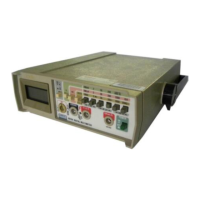THEORY
OF
OPERATION
CIRCUIT
DESCRIPTIONS
3-33.
CURRENT
CONDITIONER
3-34. The Current
Conditioner
changes
current
inputs
into
representative
voltages. This
is
done by passing
the
unknown
current through
a precision resistor and
using
the
voltage
developed
across the resistor.
If the
proper
resistance (i.e.,
range) is
selected,
the
voltage
across the
resistor (after
passing
through
the True
RMS
Converter)
will
be
within the range of
the A/D Converter.
These
resistors are a
special type of high power
precision
resistors known
as current
shunts. (They route
or shunt
the
current around the
meter.)
Figure
3-3
(part
B) shows
a
simplified
schematic of
the current
input signal
conditioner
for current
measurements.
The range
switches determine
the combination of current
shunts
used
the measurements. The
resistances
of
the
five current
shunts
are precisely
lOOOO,
1000, 1.000,
and
0.1000.
The
position of the AC/ DC
switch
(on
the
front panel)
sends the
voltage
output of the
current
conditioner
to
either the
True
RMS
Converter or the A/D
Converter.
3-35.
The
10
Amp
function
of the
8010A sends
the
measured
current from
the lOA input terminal
through
a
separate
current shunt of 0.010. The voltage
developed
across
the shunt
is processed
the same as all other
current
measurements.
3-36.
RESISTANCE
CONDITIONER
3-37.
The
resistance conditioner uses the same
voltage
divider as
for
voltage
measurements.
For
resistance
measurements
the signal conditioner is used only
as
a
reference resistor.
3-38.
Your
Multimeter
uses the ratio
method
to
measure an unknown
resistance. Figure
3-3
(part
C)
shows
a simplified
schematic of
the
input
signal
conditioner
for resistance and conductance
measurements.
The
reference resistor
is
placed
in series
with the
unknown
resistance and a voltage
source (V
SOURCE)
is
applied
across them. The
ratio of the
resistances
equals the ratio of the voltage drops
across
the
respective resistances:
n
Unknown
__
V Unknown
n
Reference
V Reference
The
A/D
Converter
measures
the voltage ratio and
the
value
of the
unknown
resistance is
calculated.
3-39.
The
voltage drop
across the
unknown
resistance is
applied
to the
HI
and LO
inputs of the A/D Converter.
The
voltage drop
across the
reference resistor is used
as
the
reference
voltage
for the
A/D
Converter. The range
switches
select
the
reference
resistance (from
the voltage
divider)
and
V SOURCE
so that the
inputs to
the
A/D
Converter,
stay within
the proper range. The
reference
resistance
is
selected so
that
the output of the
A/D
Converter,
displayed
on
the
LCD,
is
the value of the
unknown
resistance.
3-40.
CONDUCTANCE
CONDITIONER
3-4
1 .
The
method of
measuring conductance
is the same
as for
measuring
resistance with one
exception.
The
controller
inside the custom IC commands the
A/D
Converter
to
interchange
the unknown and reference
voltage
inputs. That is,
the
A/D Converter
uses
the
reference
voltage during
the
integrate
period and the
unknown
voltage during
the
read period.
This inverts the
voltage
ratio so
the reciprocal
of resistance (i.e.,
conductance)
is
displayed in the LCD.
3-42. RANGE SWITCHES'
3-43.
Though
the range
switches
are not input signal
conditioners,
they do control the input
signal
conditioners
so inputs to
the
Multimeter
can be processed
properly. In
addition to the functions
previously
discussed,
the range
switches
also
position the decimal
point on
the LCD
display.
3-44.
Meter
Protection
Circuits
3-45.
The
various protection circuits in your
Multimeter
protect its
critical circuits
from accidental
abuse,
such
as
overvoltage conditions, overcurrent
conditions,
and making
measurements
with the wrong
function
selected. Even if the Multimeter is
subjected to
unreasonable
abuse (i.e., applying
lOOOV
on the
2000
resistance
range) the protection circuits will
absorb
the
damage
while protecting
the
more
expensive (critical)
circuits within.
The following
paragraphs
on the
protection
circuits of the
Multimeter
are referenced to the
Main PCB
Assembly
schematic
in Section
8.
3-46.
VOLTAGE
MEASUREMENT
PROTECTION
3-47. When the
voltage measurement
function is
selected,
the
critical circuits of the Multimeter are
protected from
voltages slightly higher than the highest
range,
regardless of
the selected range.
If
the
input voltage
is
higher than
the
limit of the range selected, an overrange
indication is
displayed. The critical circuits are protected
from
input
voltages above 1200V in the following
manner:
when
an abnormally high voltage is applied to
the voltage
inputs,
the resistance of the three varistors
(RVl,
RV2, and
RV3)
drops, clamping the
Multimeter
side of R2 to
1200V. These varistors can compensate for
transients of up
to 6000V. If the input voltage exceeds
6000V and
generates 'enough heat to destroy
R2,
the
resistor will
destnict (open) without creating a potential
fire hazard.
Resistor R16
(1
Mfl, 1
W)
is a current-limiting
resistor
that
protects
U3
from dc voltage
inputs of up to
lOOOV
(on
low
ranges). Resistor R14
(100
kO, 2W)
is
a
current
limiting resistor that protects the input
buffer of
the
True RMS
Converter
for inputs of 750V rms or
lOOOV
peak
continuous
for the +200
mV
and ±2V
ranges. On
these two
ranges, if
a high level input
is applied
for
more
than the
10
second maximum, R14 may be damaged and
no longer
provide the proper protection.
The
input
divider attenuation
provides additional
protection on all
other ranges.
3-6

